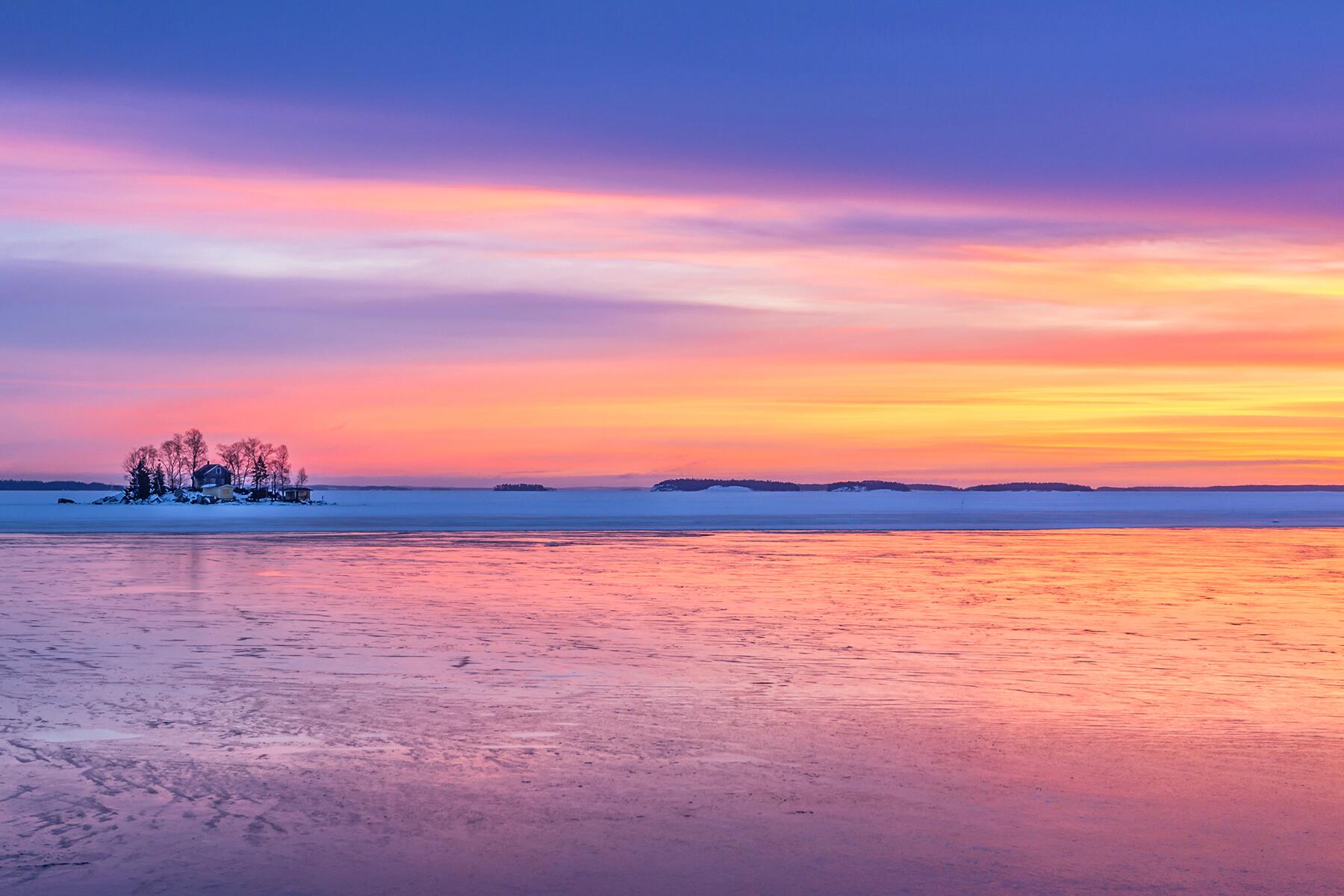- ⁄
- Travel News
- ⁄
- Outdoors
From ice caves to mountains to otherworldly dunes, these spectacular land formations look like art.
While traveling, we sometimes encounter places that seem straight out of a Hollywood movie set, only that here the production designer is none other than our very own planet Earth. These mesmerizing landforms are one of the Earth’s best creations that will leave you awestruck. From breathtaking waterfalls to enigmatic caves, Mother Nature has certainly outdone herself while creating the following land formations. While these places may look like a scene from a fairy tale, sci-fi movie, or even something photoshopped, we assure you they’re absolutely real. And, best of all, you can actually travel to most of them.
Top Picks for You
Nelchina Glacier Ice Cave
WHERE: Alaska
One look at the Nelchina Caves, and you’ll think you were transported to Disney’s Ice Age. A striking combination of strength and fragility, this tunnel of stunning blue snow and ice formations leaves an indelible mark on every visitor. Sunlight streams down through the diaphanous ice, casting dreamy shadows and intense blue colors on the cave’s walls.
Interestingly, the journey to this glacier is as beautiful as the destination. Driving snow machines through snowy forests, over frozen rivers, and vast river valleys into the picture-perfect Alaskan wilderness is an experience of a lifetime. For better or worse, the area gets very few visitors due to its extreme remoteness, but those who do make it are rewarded with the pristine beauty of unspoiled nature.
Hang Son Doong
WHERE: Quảng Bình, Vietnam
Imagine a gigantic prehistoric cave with clouds billowing out of the entrance, sounds of a river raging from somewhere inside the cave, and a strong cold wind blowing out from it. We’ve all seen a scene like this before, right? Usually in some fantasy fiction films or in some nature-based crime thrillers. But guess what? A place like this actually exists.
Hang Son Doong is the largest cave in the world, with its mysterious aura, towering stalagmites, spectacular skylights, enchanting phytokarst, and rare cave pearls. Formed about two to five million years ago, the cave is so huge that it has its own localized weather system with mist, winds, and rain clouds forming inside. In this biodiversity hotspot, one has to crawl, swim, abseil, and mount up like animals to witness and explore the caves. This serene retreat is miles away from the helter-skelter of urbanity, making it a perfect fit for adventure seekers.
INSIDER TIPEach year, only a few fortunate adventurers get to witness the out-of-the-world beauty of this UNESCO-protected cave. Book a slot well in advance to seal your opportunity for this once-in-a-lifetime experience.
Recommended Fodor’s Video
Baatara Gorge Waterfall
WHERE: Meghraq, Lebanon
British novelist Roald Dahl once wrote: “The greatest secrets are always hidden in the most unlikely places.” This perfectly describes the awe-inspiring Baatara Gorge Waterfall in Lebanon, a scene reminiscent of Lord of the Rings. The unexpected waterfall plunges an astounding 837 feet into a cave and falls behind three natural bridges, which raise one above the other and overhang a chasm descending into the depths of Mount Lebanon.
Also known as “The Cave of Three Bridges,” this uniquely distinctive waterfall is the product of millions of years of Jurassic limestone erosion. Geologists report that it is around 160 million years old and must have been around when dinosaurs roamed the area. The remarkable natural beauty of this incredible structure makes it one of the greatest natural marvels of the region. Strap on your backpack and hike to the site, as this picturesque waterfall should be on your bucket list.
Dzukou Valley
WHERE: Nagaland, India
The Dzükou Valley, in northeast India, is a hidden paradise. The valley is a picture-perfect postcard masterpiece of nature’s handiwork that belongs in a fairy tale or fantasy novel. Stretching as far as the eye can see, the Dzükou valley boasts a treeless sweep of rolling hillocks, verdant glens, river-cut ravines, meandering clear rivulets, and vibrant multi-colored wildflowers. The valley’s beauty largely derives from its interesting topography, sculpted over millennia by the geological processes of weathering and erosion. The convoluted folds, ripples, and contours of the valley are a marvel to witness, and few travelers will have ever observed anything like this before. Owing to its remoteness, this serene retreat is largely untouched.
INSIDER TIPIf you plan this trip in the month of December, you can also witness Nagaland’s fascinating Hornbill Festival, celebrated in the first week of December every year.
Richat Structure
WHERE: Ouadâne, Mauritania
Unlike other places in the list, this landform doesn’t offer much to see at ground level and is said to be best visible from space. Also known as the “Eye of the Sahara,” the Richat Structure is a unique giant circular feature that looks like a bull’s eye in the otherwise featureless expanse of the Sahara Desert. At first glance, it resembles a remnant of a meteor impact. However, it comprises what geologists call a domed anticline, likely due to volcanic activity followed by millions of years of erosion, revealing layers of older sedimentary rocks beneath newly formed rocks. Though it looks like something you’d encounter on Mars or Jupiter, this geological wonder is located right here on Earth.
Tianzi Mountains
WHERE: Hunan, China
Remember the floating mountains from Avatar? Those mystical mountains weren’t fictional and actually exist on Earth. They are the uniquely stunning Tianzi Mountains located in Zhangjiajie, China. Often surrounded by mist, the tower-like peaks of the Tianzi Mountains abruptly rise up from the tree-covered ground beneath to produce a landscape like no other. No wonder James Cameron pulled inspiration from these mountains for the fictional world of “Pandora.” This wonderful landscape is the product of millions of years of sedimentary rock erosion. The weathered, slender, jagged ancient sandstone pinnacles, some as tall as about 4,100 feet, are nature’s version of skyscrapers.
INSIDER TIPTourists can best explore the mountain peaks up close in a cable car.
Cave of Crystals (Naica Mine)
WHERE: Chihuahua, Mexico
Deep under a mountain in the tiny mining town of Naica, Mexico, lies a magnificent underground spectacle: the enormous Cave of Crystals. The cave is home to the largest crystalline formations ever found on Earth. This horseshoe-shaped cave is filled with massive, milky-white selenite crystals and looks eerily like Superman’s Fortress of Solitude.
However, this real-life version is stiflingly hot, the air is acidic, the humidity high, and no natural light enters. Scientists speculate that a mass of boiling magma directly beneath the cave forced hot, mineral-rich waters into caverns and gaps, birthed, and supercharged these giant crystals’ growth. The ideal conditions for growing crystals are completely inhospitable for humans. Unsurprisingly, the Cave of Crystals is not a tourist destination, but its mysterious beauty enables us to understand the endless hidden possibilities of our planet.
Lençóis Maranhenses
WHERE: Maranhão, Brazil
The phenomenal Lençóis Maranhenses National Park is neither a mirage nor a movie set but one of the world’s most dramatic landscapes. Thousands of dazzling blue lagoons hide below towering otherworldly sand dunes. Every oasis of turquoise lakes invites travelers to toil across the pristine white sand and hurl themselves into the beautiful abyss. This pristine retreat is certainly too good to be true. Lençóis Maranhenses has been shaped over thousands of years as the sand from riverbeds is accumulated at the mouth of the rivers and brought back to the continent by winds and sea currents. The best time to experience these brilliant pools of paradise up close and personal is during the rainy season when it’s still sunny, and every trough is filled with cerulean waters.
Cenote Ik Kil
WHERE: Yucatán, Mexico
The Ik Kil Cenote reminisces a scenery straight out of a fairy tale where the magic of nature manifests in the most evident and powerful way. Cenote Ik Kil is a deep natural sinkhole formed by collapsing of a cave. Back in the day, the Mayans considered cenotes sacred and used the site to practice rituals and offerings. The walls of the cenote are enveloped in green leaves and vines hanging down beautifully from the top all the way down to the water, tempting visitors to swing like Tarzan. Its magnificent size, perfectly circular shape, straight-high walls covered in enchanting vines, waterfalls spilling through its walls, and solemn, mystical vibe make Ik Kil one of the most alluring cenotes in the world. Walking down the stairs that lead to the cenote’s water feels like descending into a mystical cave in which the magical side of nature is always to be found.
INSIDER TIPIt’s highly recommended to swim out to the middle of the natural pool, floating on your back to admire the open-air circle above.
Marble Caves
WHERE: Patagonia, Chile
The enchanting Marble Caves in Chile are a unique natural wonder with their gorgeous myriad of colors and mesmerizing layered textures. Over 6,200 years, the huge marble deposits on the edge of the General Carrerra Lake have been naturally eroded by wave action, creating caverns, tunnels, arches, and huge columns of pure marble.
Embark on a one-of-a-kind boat or kayak excursion to explore a labyrinth of water-sculpted incredible blue caverns and intricate caves that will leave you breathless. The mineral impurities in the marble have turned into beautiful calligraphy swirls of dramatic pink and blue across the walls. The water beneath is an almost luminescent turquoise, and the light reflects across the soft pinks, blues, yellows, and greens that run through the marble. Prepare to be utterly captivated by an impressive cerulean display of colors skillfully illustrated by Mother Nature.
Stone Forest
WHERE: Melaky, Madagascar
Tsingy de Bemaraha National Park is home to a sprawling limestone formation that consists of thousands of spiky jagged towers soaring hundreds of feet into the air, separated by slot canyons. Popularly known as Stone Forest, these limestone karsts’ peaks, points, and wavy edges are otherworldly and look more like a scene from a sci-fi film. This almost impenetrable rock labyrinth shelters some of the world’s rarest and most diverse wildlife. The formation of this alien-looking geological wonder began some 200 million years ago as a result of tectonic activity and erosion. The grandiosity of this spectacular natural landscape attracts determined nature revelers, mountain and rock climbers, wildlife enthusiasts, scientists, and anyone else who cherishes being awed by Mother Nature.
INSIDER TIPAs it is a rather adventurous activity exploring the limestone labyrinth, climbing ladders and crossing suspended swing bridges, and at some points even strapped to a harness, we recommend travelers to have a moderate level of fitness.
Jökulsárlón Glacier Lagoon
WHERE: Iceland
The glacial lagoon of Jökulsárlón and its frozen beach is one of Iceland’s natural crown jewels. The glistening blue and white floating icebergs of all shapes and sizes break off the glacier and peacefully make their way into the lagoon forming an otherworldly landscape. These impressive icebergs, with their glittering colors, are a treat to the eyes and indeed nature’s seasoned handiwork. A popular location for many big Hollywood films, be prepared to be blown away by the stunning vastness and unique beauty of majestic icebergs sailing through the enormous lagoon into the Atlantic Ocean.
INSIDER TIPJökulsárlón, though accessible all year round has an added advantage if visited in winter. In winter, travelers can also catch the mesmerizing northern lights.





